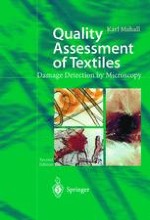2003 | OriginalPaper | Buchkapitel
Chemical Damage
verfasst von : Dipl.-Ing. Karl Mahall
Erschienen in: Quality Assessment of Textiles
Verlag: Springer Berlin Heidelberg
Enthalten in: Professional Book Archive
Aktivieren Sie unsere intelligente Suche, um passende Fachinhalte oder Patente zu finden.
Wählen Sie Textabschnitte aus um mit Künstlicher Intelligenz passenden Patente zu finden. powered by
Markieren Sie Textabschnitte, um KI-gestützt weitere passende Inhalte zu finden. powered by
Wool fibers have an extremely complicated structure and characteristic scales, Fig. 26, by which they can be distinguished from other fibers. Apart from this, structural abnormalities, i. e. damage, can be detected quite easily under the microscope. Staining reactions with Cotton Blue-lactophenol [11], Neocarmin W (Fesago, Heidelberg) or Pauly reagent [12] simplify the recognition of wool damage. With Cotton Blue-lactophenol, damaged wool fibers are dyed blue, Fig. 27. With Neocarmin W — a dye solution used to distinguish various fibrous materials — undamaged wool is dyed yellow and damaged wool orange. It is very easy to perform this staining reaction. The sample is placed into the dye solution for 5 minutes at room temperature and then rinsed. However, slight damage is either not indicated or only indistinctly. The reagent responds best to badly alkaline-damaged wool, Fig. 28.
